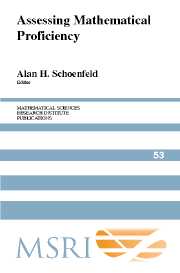Book contents
- Frontmatter
- Contents
- Preface
- Acknowledgments
- Section 1 The Big Picture
- Section 2 Perspectives on Mathematical Proficiency
- Section 3 What Does Assessment Assess? Issues and Examples
- 6 Mathematical Proficiency: What Is Important? How Can It Be Measured?
- 7 Aspects of the Art of Assessment Design
- 8 Mathematical Proficiency for Citizenship
- 9 Learning from Assessment
- 10 When Assessment Guides Instruction: Silicon Valley's Mathematics Assessment Collaborative
- Section 4 The Case of Algebra
- Section 5 What Do Assessments Assess? The Case of Fractions
- Section 6 The Importance of Societal Context
- Epilogue: What Do We Need to Know? Items for a Research Agenda
- About the Authors
- Subject Index
- Author Index
- Task Index
8 - Mathematical Proficiency for Citizenship
Published online by Cambridge University Press: 06 July 2010
- Frontmatter
- Contents
- Preface
- Acknowledgments
- Section 1 The Big Picture
- Section 2 Perspectives on Mathematical Proficiency
- Section 3 What Does Assessment Assess? Issues and Examples
- 6 Mathematical Proficiency: What Is Important? How Can It Be Measured?
- 7 Aspects of the Art of Assessment Design
- 8 Mathematical Proficiency for Citizenship
- 9 Learning from Assessment
- 10 When Assessment Guides Instruction: Silicon Valley's Mathematics Assessment Collaborative
- Section 4 The Case of Algebra
- Section 5 What Do Assessments Assess? The Case of Fractions
- Section 6 The Importance of Societal Context
- Epilogue: What Do We Need to Know? Items for a Research Agenda
- About the Authors
- Subject Index
- Author Index
- Task Index
Summary
Number and U.S. Democracy
“Numbers have immeasurably altered the character of American society,” wrote Patricia Cohen in 1982 in the concluding pages of her book A Calculating People. Cohen continues, “Our modern reliance on numbers and quantification was born and nurtured in the scientific and commercial worlds of the seventeenth century and grew in scope in the early nineteenth century, under the twin impacts of republican ideology and economic development.” In the two decades since Cohen's book, reliance on numbers and quantification has increased well beyond what could have been imagined, and no end is in sight.
Quantification emerged in seventeenth-century Western Europe as an alternative to the classical Aristotelian systems of classification as a way to make sense of the world [Crosby 1997]. England was becoming a commercial capital and numbers were needed to describe the economy. Arabic numerals finally had been adopted and the first books on arithmetic had appeared. Education in arithmetic was beginning but was an arcane subject, cut into small bits, and not easy to learn. Arithmetic as a commercial subject was disconnected from formal mathematics [Cohen 1982]. To a larger extent than I believe healthy, both these circumstances still exist today.
Inherent demands of a democracy, a large diverse country, and persistently aggressive economic development have fed the historical inclination of U.S. culture toward quantification to its enormity of today.
- Type
- Chapter
- Information
- Assessing Mathematical Proficiency , pp. 113 - 124Publisher: Cambridge University PressPrint publication year: 2007



